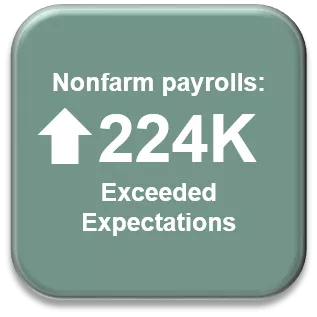Economic Commentary: Significant shift in U.S. monetary policy and what the June employment report revealed

Over the past six weeks, expectations for U.S. monetary policy have experienced a significant shift. At the end of May, markets were pricing in a 48% chance of a rate cut at the July 31 Federal Open Market Committee (FOMC) meeting. Today it is a foregone conclusion (100% probability) that Fed Funds will be lowered by 25 basis points at the July 31 meeting with another 25-basis-point cut in rates highly likely before the end of the year. That would bring the Fed Funds upper range target to 2.00% from the current 2.50%.
So, why the sudden shift? Although inflation measures generally remain below the 2% target set by the Fed and thus might warrant some form of monetary stimulation, the main reason for the sudden dovishness in Fed comments is risk management. The recently published minutes of the June Fed meeting cited ongoing trade tension uncertainties coupled with the general slowing of global economic activity as concerns. In the U.S., the commentary also noted ongoing weakness in business investment, slowing activity in the nation’s factories, and a sluggish housing market.
In recent remarks, Fed Chairman Powell has noted that the inability for inflation to accelerate to the 2% level may be more than a transitory problem, a change in his commentary from earlier in the year. Not explicitly mentioned was the fact that a couple of rate cuts by the Fed may cause the value of the U.S. dollar to weaken, resulting in higher import prices that could increase inflationary pressures.
Despite its concerns, the Fed does not believe that the economy is at risk of slipping into recession and said that “overall financial conditions remained supportive of growth.” It is viewing the potential interest rate cut(s) as an insurance policy.

The recently released employment report for June indicated that the labor market bounced back from the weakness in May. Nonfarm payrolls increased 224,000 in June, surpassing the consensus estimate of 160,000, following the meager 72,000 gain in May. Job gains were broad-based across most industries, including those that should be most susceptible to trade tensions. The three-month average of job gains is a healthy 172,000.
The unemployment rate ticked up 0.1% to 3.7% as the labor force expanded by more than gains in the Household Survey. Year-over-year average hourly earnings growth remained steady at 3.1%. The long-anticipated acceleration in wage growth has still not arrived.
The bond market continues to price in a slower growth and low inflation environment. After 10-year yields declined 43 basis points in May, the rate of decline has eased with yields trading between 1.95% and 2.25% the past six weeks. The most recent 10-year yield is 2.11%. The yield curve remains inverted out to about 15 years. As discussed in prior commentaries, an inverted yield curve has preceded every recession over the past 50 years, but the lead time is inexact – ranging from 6 months to 22 months.
In summary, most of the trends that have been discussed in these monthly commentaries have not changed and continue to point to a slower growth environment. The main thing that has changed over the past six weeks is the public recognition by the Fed that these slowing trends will likely require some response via interest rate policy. In general, the markets had correctly been recognizing these trends and anticipating a need for Fed action. The recent Fed rhetoric only confirms what the markets have expected.
Insights
Research to help you make knowledgeable investment decisions